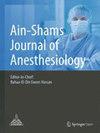Comparison of dose–response to two different doses of intravenous lidocaine for analgesia in patients undergoing elective laparoscopic cholecystectomy under general anesthesia
IF 0.5
Q4 ANESTHESIOLOGY
引用次数: 0
Abstract
Abstract Background Various studies have demonstrated the analgesic benefit of systemic lidocaine in the perioperative setting, especially during laparoscopic abdominal surgery. However, the best appropriate dose for an administered bolus and continuous infusion of lignocaine is unclear. Our aim is to compare the effect of two different doses of intravenous lidocaine for analgesia in patients undergoing elective laparoscopic cholecystectomy under general anesthesia. Fifty-four patients of ASA PS I or II, aged between 18 and 65 years undergoing elective laparoscopic cholecystectomy under general anesthesia were randomly divided into two groups of 26 patients each. Patients in group A received an intravenous bolus injection of lidocaine 1.5 mg/kg slowly over 10 min, prior to induction and then followed by a continuous infusion at the rate of 1.5 mg/kg/h via infusion pump whereas group B patients received intravenous lidocaine bolus of 1.5 mg/kg slowly over 10 min followed by infusion at the rate of 2 mg/kg/h. Postoperative analgesia was assessed by VAS score, time to first analgesic dose, and total consumption of rescue analgesic in 24 h. Results There was a statistically significant difference in mean VAS Scores between the two groups at different time intervals postoperatively. Time to first rescue analgesia was earlier in group A (30.65 min) compared to group B (49.42 min) and the difference was statistically significant. Total consumption of rescue analgesic was higher in group A with a mean of 178.85 mg compared to 126.92 mg in group B. Conclusion Both the infusion doses of Lidocaine provided clinically adequate analgesia postoperatively but the infusion dose of 2 mg/kg/h had a mean VAS score significantly lower than 1.5 mg/kg/h.选择性腹腔镜胆囊切除术全麻下静脉注射两种不同剂量利多卡因镇痛的剂量反应比较
各种研究已经证明全身利多卡因在围手术期的镇痛作用,特别是在腹腔镜腹部手术中。然而,给药和持续输注利多卡因的最佳适当剂量尚不清楚。我们的目的是比较两种不同剂量的静脉利多卡因在全麻下择期腹腔镜胆囊切除术患者的镇痛效果。选择54例ASA PS I或II级患者,年龄18 ~ 65岁,在全麻下行选择性腹腔镜胆囊切除术,随机分为两组,每组26例。A组患者在诱导前先静脉滴注利多卡因1.5 mg/kg,缓慢注射10 min,然后通过输注泵以1.5 mg/kg/h的速度持续输注;B组患者静脉滴注利多卡因1.5 mg/kg,缓慢注射10 min,然后以2 mg/kg/h的速度持续输注。通过VAS评分、第一次给药时间、24 h抢救镇痛药总消耗来评价两组患者术后镇痛效果。结果两组患者术后不同时间间隔VAS评分平均值比较,差异均有统计学意义。A组第一次抢救镇痛时间(30.65 min)早于B组(49.42 min),差异有统计学意义。A组抢救镇痛药总用量平均为178.85 mg,高于b组126.92 mg。结论利多卡因输注剂量均能提供临床足够的术后镇痛,但输注剂量为2 mg/kg/h时VAS评分均显著低于1.5 mg/kg/h。
本文章由计算机程序翻译,如有差异,请以英文原文为准。
求助全文
约1分钟内获得全文
求助全文

 求助内容:
求助内容: 应助结果提醒方式:
应助结果提醒方式:


